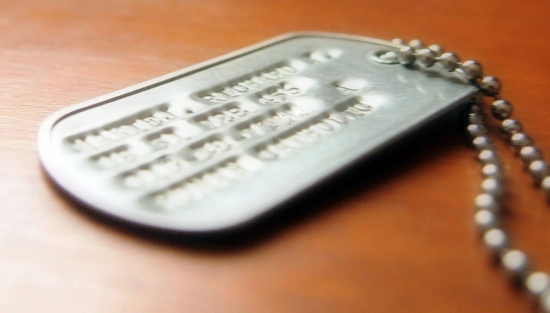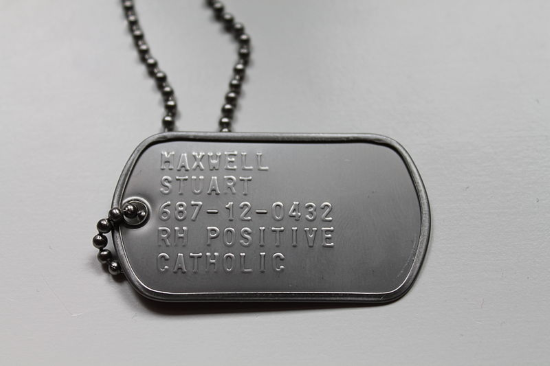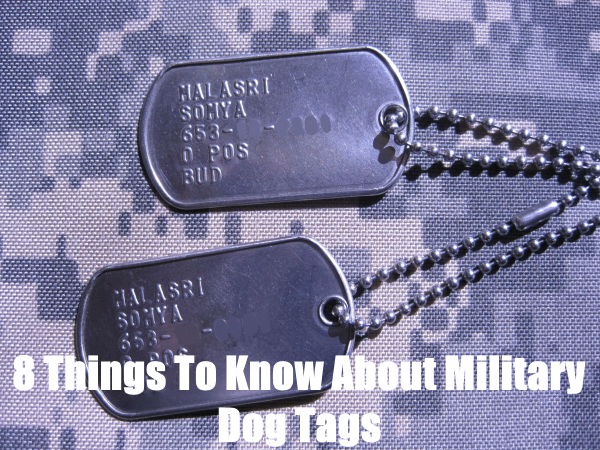Military dog tags are one of the most recognizable features of a uniform.
The iconic piece of identification has origins with the military that dates back more than 150 years.
As a result, dog tags are generally considered one of the most symbolic features of military service.
Military dog tags earned their nickname for the manner they drape around the neck.
However, the main purpose of dog tags is far more morbid.
Learn everything you need to know about U.S. Armed Forces identification, including the 8 things that are on military dog tags.
Related Article – Replace Military Dog Tags
What Are Military Dog Tags?

The U.S. Armed Forces need a method to identify soldiers, including when they are deceased.
For this reason, military dog tags were created over 150 years ago for this purpose.
However, dog tags (given the nickname because they resembled the ID tags worn by our favorite pets) also serve as a source of pride.
While military dog tags are primarily designed to identify soldiers that are seriously injured or killed on the battlefield, they are also a testament to survival.
Consequently, many veterans value their dog tags as an incredible source of pride and honor.
For some, it becomes a sentimental token to a fellow soldier and friend lost in combat.
It’s believed that newspaper tycoon William Randolph Hearst coined the nickname “dog tags.” for modern military identification.
Reportedly, Hearst was not a fan of President Franklin D. Roosevelt’s New Deal program. Hearst made the name up when he heard that the brand new Social Security Administration considered issuing metal nameplates with social security numbers.
Hearst, a newspaper magnate, wasn’t a fan of the new retirement program and referred to the proposed metal plates as “dog tags” as worn by the military in a derogatory fashion.
Nevertheless, more than a century later, military dog tags remain iconic as well as cherished by veterans.
Purpose
Military dog tags provide essential information about the soldier.
It includes personal information such as full name, blood type, and inoculation history (more information, below).
Military dog tags are rust-resistant and traditionally worn with a chain that hangs around the neck.
It’s normal for soldiers to wear a pair of dog tags with duplicate information.
The purpose of the second tag is that it can be removed from the soldier in the event of death. It serves as a record of the event, while the first tag remains in place to identify the body.
History
The history of military dog tags is extensive.
For starters, you can trace the origins of identification tags back to the Spartans.
The legendary Greek warriors were known to carve their names on sticks which they then tied to the wrist.
Furthermore, Legionaries in the Roman army wore lead disks around their necks engraved with personal details.
Regardless, it was the Chinese military that became the first in the modern era to incorporate identification tags into the uniform.
In the mid-19th century, Chinese soldiers wore tags attached to belts that were made from wood.
Meanwhile, in the United States, military dog tags have origins from the Civil War era.
Sadly, due to the high causality rate, there was a pressing need for a standard identification system.
Consequently, soldiers adopted multiple methods (sewing names to a uniform, pinning notes to a uniform, etc) for creating identification.
Later, metal tags or pins became more practical since they are durable and resistant to moisture and damage.
It wasn’t until the early 20th century that the U.S. Army made dog tags compulsory for enlisted personnel.
The original military dog tags consisted of 1) the name, 2) rank, 3) the company, and 4) the regiment of the soldier.
At first, it was mandatory in the U.S. Army to display dog tags around the neck.
Regulations changed by 1916 when two dog tags were required.
The U.S. Navy didn’t make the wear of dog tags a mandatory piece of the sailor uniform until 1917.
World War II
In the past, military dog tags looked a lot different than they do now.
The WWII version featured a small notch that was designed for twisted intentions.
The rumor was the small notch allowed the tags to be stuck between the teeth (and therefore not lost) while the dead soldier was transported back home.
Fortunately, it’s just a rumor, as the actual purpose behind the notch was far less grim.
It simply allowed the tag to be placed correctly in the machine that printed off the embossed letters.
During this era, military dog tags also included information such as:
- Service Number
- Blood Type
- Emergency Contact Name
- Emergency Contact Address
- Vaccination Information
After World War II, the DoD elected to drop the next of kin / emergency contact information from standard-issue dog tags.
Vietnam

The U.S. Armed Forces removed the notorious small notch from dog tags beginning in the Vietnam era.
Otherwise, military dog tags largely resembled the previous version from World War II.
Moreover, some of the personal details on the individual’s dog tags did change.
For example, the soldier’s service number was replaced with the individual’s social security number.
Later, in 2015, the military replaced the social security number with the soldier’s Defense Department ID number. As identity theft flourished in the 21st century, it just made the most sense.
8 Things That Are on Military Dog Tags
“What is on military dog tags?”
It’s a frequently asked question regarding military uniform standards.
Military dog tags feature important information about the individual.
Therefore, the information can be utilized to identify a victim that is badly injured or killed in combat.
Moreover, military dog tags are a symbol of their courageous service and dedication to their country.
They are a token of that service, as well as a badge of survival.
Here are the 8 Things That Are on Military Dog Tags:
#1. Name
The first, and most critical piece of information, is the name of the soldier.
As a result, it’s not surprising that the soldier’s name composes the first lines of a dog tag.
The name is generally displayed, as follows:
“Pyle
Gomer T.”
“Taylor
Chris B.”
The last name is first, followed by the first name as well as the initial of the middle name.
The current Marine Corps dog tag format uses just the initials of the first name and the middle name on the second line.
#2. Defense Department ID
The Defense Department ID number has replaced the social security number for identification purposes.
The change is fairly recent having occurred in 2015 after military personnel complained about privacy issues.
Consequently, the Defense Department ID is a more confidential method for identifying personnel.
#3. Military Branch
Interestingly, only two of the military services have the branch presented on dog tags.
At this time, only the Marine Corps and the Coast Guard use the branch identifiers.
The military identifier is as follows:
- Coast Guard (“USCG”)
- Marine Corps (“USMC”)
Furthermore, the recently created U.S. Space Force has yet to develop their own version of dog tags. Since Guardians are processed through Air Force BMT, it’s likely the format matches that of the USAF.
Notwithstanding, military dog tags are also utilized by Special Forces including Navy SEALs and Army Rangers.
Delta Force and Green Berets also feature their own types of special operations dog tags.
Related Article – How To Prepare For Army Ranger School
#4. Blood Type
The blood type of the service member is also provided on dog tags.
Of course, this information is prudent in the event of massive blood loss.
The primary purpose of the dog tag, after all, is to help provide the wearer aid in the field in case of injury or death.
The universal standard makes a tremendous difference when combat medics often have only minutes to save a life.
There are 4 ABO types:
- A
- B
- AB
- O
Moreover, the blood type is determined by Rh status (Rh+ or Rh-).
All in all, there are 8 different blood types with each one being extremely unique.
The blood type determines who the individual can give and receive blood from in the event of an emergency.
It’s often displayed on dog tags like “A POS” or “O NEG”.
Related Article – 19 Vaccines Given By The US Military
#5. Religious Preference
In the past, you need to state one of three religious preferences to appear on your dog tags, whether you liked it or not.
The original intention was that the denomination would assist with religious burial requirements.
Military personnel were generally classified as “Protestant,” “Catholic,” or “Hebrew.”
Eventually, the military caught up with the rest of the country and added “no preference” and even “none” designations to dog tags.
It’s worthwhile to mention that the Department of Defense does not have any list of “approved” religions.
In the 21st century, military personnel are allowed to claim any religious belief they desire on their dog tags, including, “Atheist,” “Druid,” or even “Pastafarian.”
#6. Duplicate Information
As previously mentioned, soldiers are required to wear two different dog tags, each with the same information.
The purpose of duplicate dog tags is for the gruesome reality of warfare.
In the event of severe injury or death, it allows for one of the tags to be removed while the other remains with the body to identify it.
Soldiers usually elect to carry the duplicate dog tag on the same chain while others place the second copy in their boots.
There is no uniform requirement so long as you have the second dog tag somewhere in your possession.
Some argue that military dog tags are no longer necessary in the era of advanced DNA technology.
However, it’s a tradition that many refuse to dismiss given that dog tags represent the incredible sacrifice and commitment each soldier makes to their country.
#7. Medical/Emergency Information
Along with regular dog tags, Emergency Medical dog tags are assigned to personnel with health issues.
These tags are easily identifiable thanks to the bright red aluminum metal.
These are similar to medical alert bracelets. Emergency dog tags provide important information critical to medical professionals if the individual is unresponsive.
In general, medical military dog tags provide the following information:
- Last name and initials
- DoD ID Number
- Allergy Information
- Medical Conditions
- Potential Complications
- Prescription Information
The information displayed usually depends on the conditions of each individual.
It’s like a medical bracelet that first responders and physicians can quickly access in an emergency situation.
- Ikon Pass Military Discount: Learn How To Save Big - January 31, 2025
- RTIC Military Discount: Find Out How To Save Big on Gear - January 30, 2025
- Traeger Military Discount: Learn How To Save Big on Smokers - January 28, 2025


